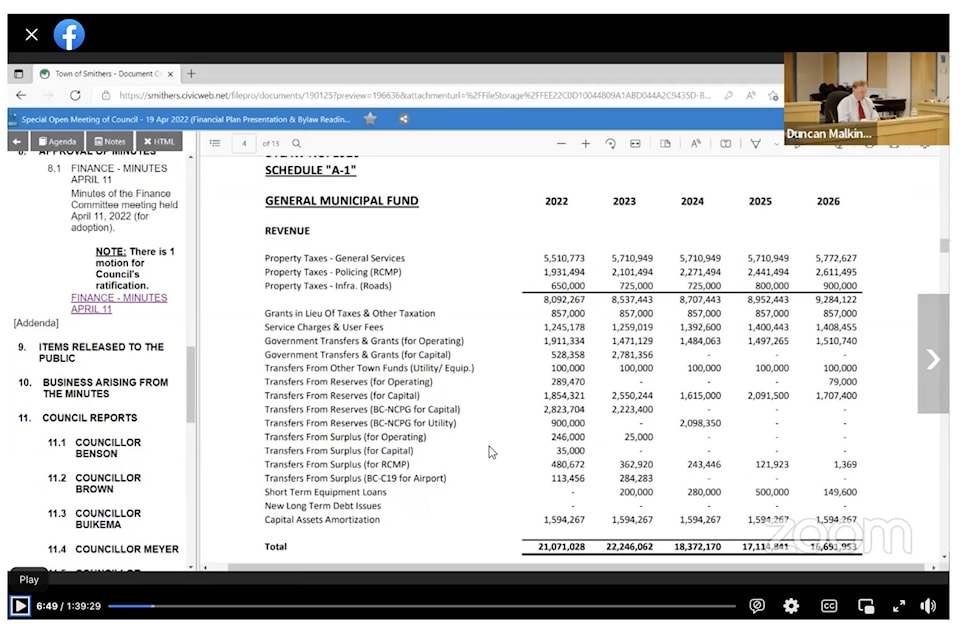Single family residential property tax payers can expect to pay, on average, $170 more this year, according to the Town of Smithers Five-Year Financial Plan (2022-2026).
At a special budget presentation April 19, William Wallace, Smithers director of finance, explained the average home in Smithers is now valued at $401,000 compared to $338,000 last year according to the 2022 BC Assessment.
Earlier, Wallace noted that a number of factors had increased the Town’s revenue requirements. In the 2021-2025 Financial Plan, revenue requirements for 2022 were estimated at $19.79 million. Following budget deliberations at the end of 2021 and early this year, that number is up to $21.07 million in the current plan.
Factors for the increase included a Municipal Service Assessment Report (“MSA”) Innova Strategy Group that recommended restructuring of Town management at a cost of $390,000 annually and reorganization of the finance department ($389,000).
READ MORE: Northwest B.C. communities get funding to support wildfire-risk mitigation
Wallace also cited an inflationary increase of $247,000 based on the Bank of Canada’s Consumer Price Index Common (CPI-common) of two per cent in late 2021 (it is now tracking closer to three per cent) and a further $80,000 allowance for rising fuel and natural gas costs.
He noted supply pricing to the Town has increased on average 15 per cent for capital projects and fuel costs are up 3o per cent.
Municipal property taxes make up the lion’s share of Smithers’ budget revenue at 48 per cent or $8.95 million ($5.5 million general, $1.9 million policing and $650,000 roads).
The 2022 BC Assessment Authority pegged the total value of property in Smithers at more than one billion dollars for the first time ($1.06 billion) up by 18 per cent over 2021.
Of this, $850 million (81 per cent) is residential (an increase of 21 per cent), primarily single family homes at $751 million.
Values for commercial class properties increased moderately at eight per cent and represent $178 million of the total assessment.
Together, residential and commercial property tax payers shoulder 84 per cent of the tax burden — 42 per cent each ($3.4 million). This may vary slightly when the Municipal Tax Rate Bylaw is drafted next week, Wallace said.
Overall, the Town has budgeted an 11.8 per cent property tax increase (9.7 per cent general, 2.1 per cent RCMP) for additional revenue of $939,000. Of this, $170,000 is being used to close an RCMP budget gap of $596,000 which the Town intends to be done with by 2026.
For the average single-family home, this means a tax bill of approximately $1,600 this year compared to $1,428 last year, Wallace said.
Utility costs will also increase by 10 per cent again this year based on the provincial mandate for municipalities to implement an asset management plan to replace aging infrastructure. In 2019, council hiked the rates for the 2020, 2021 and 2022 fiscal years.
The Town’s other major sources of revenue for 2022 include senior government grants ($6.3 million), service charges and fees ($1.25 million) and transfers from reserves ($2 million).
On the expenditure side of the balance sheet, Town operations take up $13.5 million of the $21.07 million budget. Big ticket operational items include: transportation and infrastructure, $2.9 million; RCMP, $2.5 million; recreation and cultural services, $2.1 million; corporate services, $1.9 million; fire rescue, $1.4 million; and planning and development $965,000.
Staff projects another budget increase in 2023 to $22.25 million with decreases in 2024, 2025 and 2026 to $18.37, $17.11 and $16.69 million respectively.
At the end of the presentation, council unanimously passed the first three readings of the Five-Year Financial Plan (2022-2026) Bylaw.
According to provincial law, the Town must submit its Five-Year Financial Plan Bylaw and Tax Rate Bylaw by May 16. The Finance Committee is scheduled to meet April 25 to finalize tax rate setting and the Tax Rate Bylaw for readings at council’s next regular meeting April 26.
The financial plan must be adopted before the Tax Rate Bylaw.
editor@interior-news.com
Like us on Facebook and follow us on Twitter
